P55 Extreme Overclockers: Check your sockets!
by Rajinder Gill on October 15, 2009 12:01 AM EST- Posted in
- Motherboards
We start with a picture.

The picture above is after our Core i7 870 (LGA-1156) processor was overclocked up to 5.19GHz using our cascade with a -102° Celsius evaporator head temperature under full-load. Processor VCC power draw at these frequencies is around 160W (this is possible only due to subzero cooling), as measured with a clamp meter installed at the 12V EPS power lead. Study the pictures closely and you should notice something peculiar. Keep in mind it comes from a CPU installed in the same type of socket from a particular manufacturer.
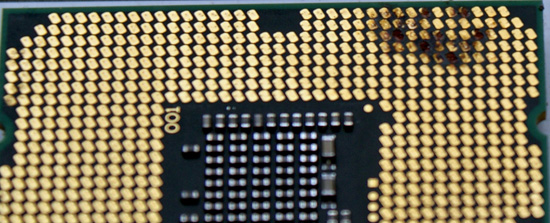
What happens after several extreme benchmark runs...
If you noticed something weird in the pictures then you understand the title of our article. We have what seems to be a potentially serious issue with proper socket loading on several P55-based motherboards when overclocking to the limit. We are of course not the only ones experiencing the problem as several of our overclocking peers have run into the same problem.
Normally we do not worry too much about mishaps during extreme overclocking testing as they are typically caused by factors outside of the supplier’s control. The overriding concern is that we have damaged every motherboard in our possession for the P55 overclocking (extreme) shootout as well as two very expensive i7/870 processors. These problems are the cause of a single component and are repeatable. As such, we thought we would provide details on current problems and will provide an update once all of the motherboard manufacturers affected have had a chance to properly respond.
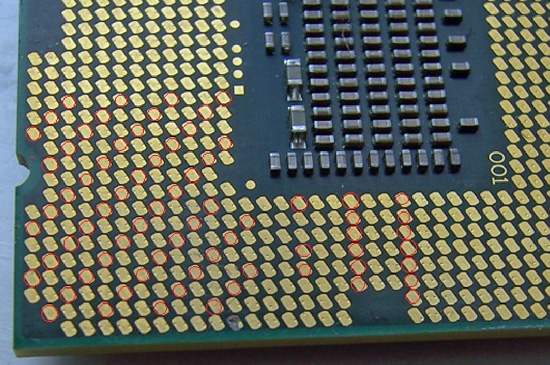
We draw your attention to the fact that the processor shown in this pictures exhibits signs of insufficient pin-to-pad contact (little to no contact) in what is a rather reproducible pattern with Foxconn manufactured 1156 sockets. As soon as an end-user mounts a CPU in a socket and latches the clamp mechanism, each pin should leave a notable mark on the associated pad.
We've marked locations where this does not seem to have happened, showing what appears to be a significant reduction in the number of VCC/VSS pins for proper power delivery, and certainly not at the right load line resistance. Damage resulting from highly overclocked use in these types of situations is not solely limited to the processor; let’s take a look at what happened to some of the motherboards in which these CPU were seated.
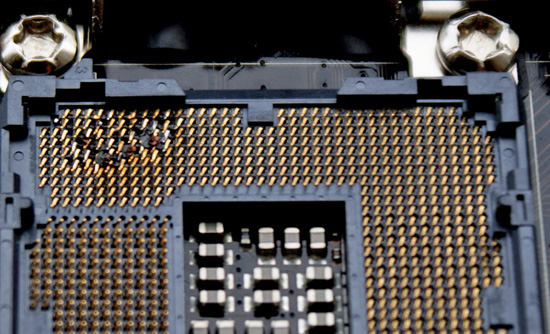

When Intel publishes socket specifications and design tolerances, it's up to component manufacturers to strictly adhere to them when designing, manufacturing, testing and ultimately selling their "compliant" components. Of course, that's not to say Intel could not have goofed when releasing their specification, leaving out a crucial tolerance or such. It could happen, but not likely. For the time being, let's assume that's not the case; seeing as how processors installed in sockets built by other companies have exhibited no such issue in testing to date.
At first glance, one might be inclined to think LGA-1156 based processors are intolerant of high-end overclocking, almost as if by design. This is correct to some extent; a quick glance at Intel’s white papers for socket 1156 CPU’s reveals that there are around 175 pads for VCC compared to over 250 for socket 1366 CPU’s. This means socket 1156 has around 66% of the current capacity of socket 1366, the caveat being that when overclocked, processors from both platforms draw similar levels of current.
When overclocked above 4GHz, processors from both platforms will draw around 15-16 amps via the EPS 12V rail to VCC, VTT and some of the other sub –system power rails under full 8 thread load from the Intel burn test (Linx). Assuming 85% PWM efficiency, we’re looking at power draw in the region of 130-140w to VCC on both platforms. The facts point toward tighter current handling tolerances for socket 1156 when compared to socket 1366, especially when it comes to non-connection of VCC/VSS power delivery pins.
Fortunately, we think we've been able to isolate pin to pad contact issues to one particular brand of parts. Physical inspection and end-user reports all but confirm the issues only affects sockets manufactured by Foxconn at this time. The only known alternative sockets in the wild are made by LOTES or Tyco AMP. We happen to have a couple of boards from EVGA using the LOTES/Tyco AMP sockets and MSI/DFI using the LOTES socket design, and thus far those boards have been issue free given highly similar operating conditions. In fact, we’ve managed to push our LGA-1156 processors further in heavy load tests on boards made using LOTES/Tyco AMP sockets than those made with sockets from Foxconn; something we’re not putting down solely to coincidence.
So far, EVGA is the only company we know that uses sockets exclusively from LOTES on their top-tier P55 boards - for example, the EVGA P55 Classified 200, model E659. This by the way may be the onus behind the decision to market the board’s “300% More Gold Content” socket statement as a purchasing option point. If you find yourself shopping for an EVGA P55 FTW, model E657, you've got a 50/50 chance of buying one with a Tyco AMP socket design (using a LOTES backplate), as opposed to one made solely with Foxconn's, the same goes for MSI and DFI who have batches of boards in the retail channel using LOTES sockets (although we're not entirely sure on socket specifics at this point). DFI told us earlier they have dropped usage of the Foxconn sockets completely until further notice. We hear the LOTES and Tyco AMP sockets are in short supply, which is probably why Foxconn's been able to fill the void in the market with what we believe to be a lower quality alternative for the extreme overclocker.
We took one of our damaged CPU’s and inserted it into one of the EVGA (LOTES/Tyco AMP) boards and took a few pics to show contact scoring and a side by side compare to the original Foxconn socket indents.
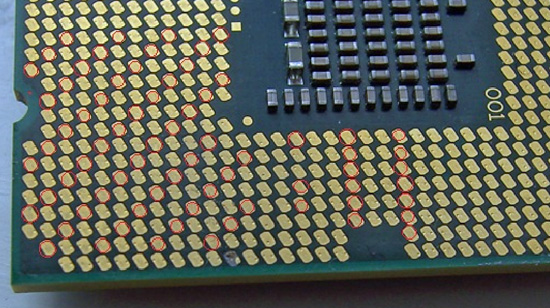
Foxconn 1156 Socket Installation
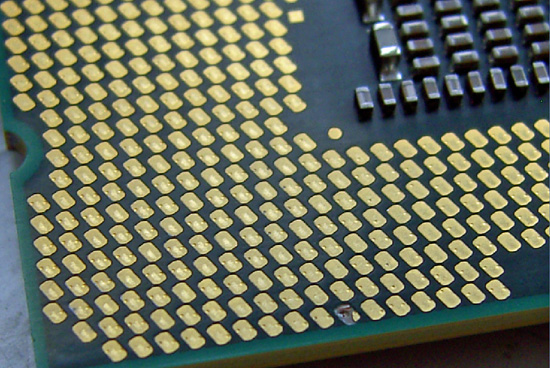
Tyco AMP / LOTES 1156 Socket Installation
Note how from a variety of angles certain pads show no evidence of contact from a Foxconn pin at all. Both the Tyco AMP and LOTES sockets have a larger pin/pad contact surface area leaving a slight scuff mark in the central area of each pad. In light of this, what we will say is that if you’re thinking of doing extreme overclocking on a board built using Foxconn's socket 1156, think again. Or, at least check your CPU for evidence of proper pin-to-pad contact.
We have not had any problems with air or water cooling overclocking up to 4.3GHz, although we do have a i5/750 that has developed a few dark pads after a thousand hours or so of constant overclocking. However, none of the boards have developed pin problems so we feel very safe in saying that any problems will probably occur only in extreme overclocking scenarios.
We also realize that partial responsibility for some of the less than acceptable CPU installations may be in fact due user installation errors. However, if users are screwing this up by doing nothing different than what they've always done when it comes to handling and installing LGA-type processors, then it's hard for us to find fault with the installer. Be aware of this situation and study the pin imprint on the CPU pads and make sure you have good contact on the VCC/VSS power delivery pads before pushing the system too hard.
















273 Comments
View All Comments
RadnorHarkonnen - Monday, October 19, 2009 - link
What is not acceptable is a short life span of a determined product.During the "Bad Caps" season (2003-2005) i blew 3 Boards during the warranty period. I Overclock, mildly.
A bit after those episodes, many OEMs extended their warranties because normal, inside specifications use, was causing problems in the end of the warranty or shortly there after.
OCing a PC, will just make it degrade faster. It took 6 months of heavy OCing a Palomino 1500+ to 1900+ to show bad caps. 2 years after, most of the "stock" PC were having problems.
It took Raj a few hours to reproduce the problem with a decent overclock. I give 6-8 months to massive failures being reproduced in stock/OEMs machines. Remember that we overclockers we take good care of our rigs, that doesn't happen with Joe Sixpack and his OEM BOX.
I work for 15 years in this world, From Bad Caps, to Bumpgates. First OCers find out, then it spreads to everybody else. We just degrade stuff faster.
Good Article Raj.
Mrwright - Monday, October 19, 2009 - link
To ClagdooshHave you even thought intel use foxconn sockets in testing? The majority of intel branded motherbards are made by foxconn? Also you comment on binning, you are ignorant and plain wrong. intel are extreamely good at producing top quality silicon and the majority of cpus are faster and un neededly binned down to lower spec models just to fill that sector of the market, thats why you get such high overlocks from the core 2 range even the celerons and pentium dual cores. so you are an idiot sir! I hate people like you!
chrnochime - Saturday, October 17, 2009 - link
Poor/inadequate braking performance on a car might lead to death, but a oc'd PC would rarely lead to the same result, unless a fire was started because of the failure of components inside a PC.OCers can certainly claim that their overclocking can lead to better tech filtered down to mainstream users who don't oc, but that's just wishful thinking. All the oc do is stress the components even more than usual, and the only thing that produce is need for better PVM/cooling, and frankly the way Intel/AMD designed their accompanying MB components, the parts are already adequate for non oc use, and then some. So what's the use for those fancy overkill heatsink/pvm when most average user won't ever need them anyway?
Racing technology that filters down to production cars actually are actually quite useful in various ways. Fancy/overkill HS/fan does little to average users.
But do continue to come up with those similarities between auto industry and the issue at hand. I always welcome entertaining(if not useful) reads.
Mrwright - Monday, October 19, 2009 - link
You are really full of opinions aren't you, with all of your posts simply causing arguements. All you do is rebut what everyone else is saying. I doubt you even have an 1156 motherboard let alone know the extent of this issue. You are trying to make out that Intel CPUs are not designed to be overclocked, but if that is the case then what is the point of the Extreme Edition line of CPUs, let alone the fact that the majority of Intels CPUs are binned down. Most Intel chips should get an extra 1GHz out of them without breaking a sweat and you have the nerve to say that OCers don't lead to anything?It is actually Ocers that lead to AMds Athlon 64 2000+ - their super energy efficient chip which uses OCer practice to make the CPU more stable at low voltage: the holy grail of overclocking.
You actually sound like an Intel representative trying to belittle this major issue.
chrnochime - Monday, October 19, 2009 - link
From what you just wrote I'd assume you've read all of my posts. If that is the case, well I'd say you got way more time than I do LOL. BTW, me having opinions is different from anyone else here, how? Please...I don't rebut everything that everyone says. If that was the case I'd reply to each and every post, wouldn't I.
Actually I don't have the 1156, but then I do frequent the various oc forums and have read up on all of the posts related to this, as much as I can.
And your mention of 1 CPU that's, according to YOU, based on OCers experience. Out of countless that either CPU manu. has released over the past ~2 decades. Isn't that amazing?
The 2000+ is just Lima Core with downclock and various energy saving optimizations. Since when did overclocker underclock anyway? Yes, what I thought, they're call OVERCLOCKER for a reason.
Want link from website, here:
http://www.nordichardware.com/news,8045.html">http://www.nordichardware.com/news,8045.html
As for you stating I'm an Intel rep; No, I'm not. I'd gladly be working at Intel, but then again if I were I'd be too busy as an Eng. there to have time to post here.
ClagMaster - Monday, October 19, 2009 - link
I am an engineer who works for an architect-engineering firm. I have master degrees in nuclear and electrical engineering. I do not work for Intel, AMD or any of the motherboard manufacturers.Some of the information on this post is bogus and I am within my rights to refute this.
Etern205 - Saturday, October 17, 2009 - link
If you check out your boards, not only is the socket made by foxconn, but other components as well like the PCIe, PCI and ram slots to even the usb portsThe name are usually stamped on the side or top if you want to see who makes it.
nofumble62 - Saturday, October 17, 2009 - link
Because the loading points are in the middle of the CPU, I suspected the CPU was not seated evenly.Have you guy tried pushing the CPU top deck hard with your thumb while closing the lever. This may help, for sure won't hurt. Also when tightening the heat sink, tighten the bolt/screws gradually in a cross pattern like you tight your car wheel.
Rajinder Gill - Saturday, October 17, 2009 - link
Tried all of that, it did not help.CW1d - Saturday, October 17, 2009 - link
hmm you would think that the chaps at AnandTech would know how to seat and mount a CPU by now. But I am pleased that it is cleared up now. OK guys no further need to ponder this, just mount your CPU cooler correctly. NOTSeriously this is a more than a simple mounting technique issue, the potential for hardware to be damaged even when run at stock is very real. While there is some redundancy built into any design, certainly the hardware is not meant to be operating with marginal contacts between pins (socket) and pads (CPU) and most certainly is not meant to be operated with so many none contacts between the pins and pads. A marginal contact is a hazard in its own right, fewer than designed contacts will place to high a burden on the remaining contact points, with the marginal contacts being most at risk. Basic electronics as many have remarked already.
For me the issue is not what is wrong specifically, rather how is it fixed. How do the motherboard manufactures and vendors react and proceed from here. They are aware of the problem, we hope. Are those afflicted motherboards recalled? What about collateral damage because of the Foxconn socket anomaly? In a litigation happy society like the US and to a lessor extent here in the UK interesting times are ahead, especially if no positive reaction from the Vendors is forthcoming.